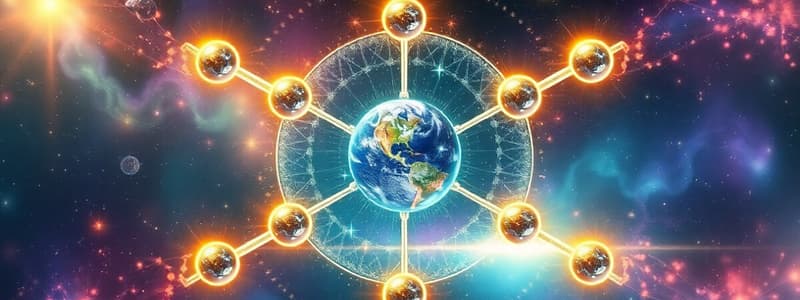Podcast
Questions and Answers
What is the molecular mass of carbon tetrachloride (CCl4)?
What is the molecular mass of carbon tetrachloride (CCl4)?
- 113.82 u
- 128.24 u
- 138.82 u
- 153.82 u (correct)
What is the molecular mass of silicon dioxide (SiO2)?
What is the molecular mass of silicon dioxide (SiO2)?
- 52.05 u
- 78.06 u
- 60.08 u (correct)
- 44.01 u
What is the atomic mass of an atom?
What is the atomic mass of an atom?
- The sum of the number of protons and neutrons in the atom's nucleus. (correct)
- The average mass of all isotopes of an element.
- The number of protons in the atom's nucleus.
- The number of neutrons in the atom's nucleus.
What is the atomic mass unit (u) defined as?
What is the atomic mass unit (u) defined as?
What is the molecular mass of trisilicon tetranitride (Si3N4)?
What is the molecular mass of trisilicon tetranitride (Si3N4)?
Why is the atomic mass of an element not always a whole number?
Why is the atomic mass of an element not always a whole number?
What is the molecular mass of disulfur difluoride (S2F2)?
What is the molecular mass of disulfur difluoride (S2F2)?
What is the approximate atomic mass of Boron based on the information provided in the text?
What is the approximate atomic mass of Boron based on the information provided in the text?
What is the molecular mass of iodine pentabromide (IBr5)?
What is the molecular mass of iodine pentabromide (IBr5)?
Calculate the molecular mass of $H_2O$.
Calculate the molecular mass of $H_2O$.
What is the molecular mass of nitrogen trichloride (NCl3)?
What is the molecular mass of nitrogen trichloride (NCl3)?
Which of the following statements is true about atomic masses?
Which of the following statements is true about atomic masses?
What is the molecular mass of diphosphorus pentoxide (P2O5)?
What is the molecular mass of diphosphorus pentoxide (P2O5)?
What is the atomic mass of lithium?
What is the atomic mass of lithium?
What is the molecular mass of $SO_2$?
What is the molecular mass of $SO_2$?
Which of the following is the most accurate way to describe the atomic mass of an element?
Which of the following is the most accurate way to describe the atomic mass of an element?
What is the charge of an ion that gains electrons?
What is the charge of an ion that gains electrons?
What is the driving force for atoms to achieve a stable electronic configuration?
What is the driving force for atoms to achieve a stable electronic configuration?
What is the term used to describe the tendency of an atom to obtain an octet of valence electrons?
What is the term used to describe the tendency of an atom to obtain an octet of valence electrons?
Which of the following statements accurately describes ionic bonding?
Which of the following statements accurately describes ionic bonding?
What is the name of the positively charged ion formed when a potassium atom loses an electron?
What is the name of the positively charged ion formed when a potassium atom loses an electron?
Which of the following elements is a noble gas?
Which of the following elements is a noble gas?
Which of the following correctly describes the electronic configuration of an atom?
Which of the following correctly describes the electronic configuration of an atom?
What is the result of an atom losing an electron?
What is the result of an atom losing an electron?
Which of the following is an example of an ionic compound?
Which of the following is an example of an ionic compound?
What is the name of the negatively charged ion formed when a chlorine atom gains an electron?
What is the name of the negatively charged ion formed when a chlorine atom gains an electron?
Which of the following is NOT a characteristic of ionic bonding?
Which of the following is NOT a characteristic of ionic bonding?
Flashcards
Atomic Mass Unit (u)
Atomic Mass Unit (u)
A unit that describes the masses of individual atoms and molecules, defined as one-twelfth of the mass of a carbon-12 atom.
Mass of Protons and Neutrons
Mass of Protons and Neutrons
Proton: 1.00728 u, Neutron: 1.00866 u, Electron: 0.000549 u.
Atomic Mass vs Mass Number
Atomic Mass vs Mass Number
Atomic mass is the weighted average of isotopes, while mass number is the total count of protons and neutrons in an atom.
Isotopes
Isotopes
Signup and view all the flashcards
Weighted Average of Atomic Mass
Weighted Average of Atomic Mass
Signup and view all the flashcards
Atomic Mass Example (Boron)
Atomic Mass Example (Boron)
Signup and view all the flashcards
Molecular Mass
Molecular Mass
Signup and view all the flashcards
Calculating Molecular Mass (N2O3)
Calculating Molecular Mass (N2O3)
Signup and view all the flashcards
Atomic Mass
Atomic Mass
Signup and view all the flashcards
Mass Number
Mass Number
Signup and view all the flashcards
Molecules
Molecules
Signup and view all the flashcards
Atomic Number
Atomic Number
Signup and view all the flashcards
Element Symbols
Element Symbols
Signup and view all the flashcards
Ionic Compounds
Ionic Compounds
Signup and view all the flashcards
Ions
Ions
Signup and view all the flashcards
Cations
Cations
Signup and view all the flashcards
Anions
Anions
Signup and view all the flashcards
Octet Rule
Octet Rule
Signup and view all the flashcards
Ionic Bonding
Ionic Bonding
Signup and view all the flashcards
Covalent Bonding
Covalent Bonding
Signup and view all the flashcards
Naming Cations
Naming Cations
Signup and view all the flashcards
Naming Anions
Naming Anions
Signup and view all the flashcards
Electron Configuration
Electron Configuration
Signup and view all the flashcards
Study Notes
Atomic Masses, Ions, and Ionic Compounds
- Atomic mass unit (u) is a unit used to describe the masses of individual atoms and molecules, instead of grams or kilograms
- Defined as one-twelfth the mass of a carbon-12 atom which has 6 protons and 6 neutrons.
- Proton mass: approximately 1.00728 u
- Neutron mass: approximately 1.00866 u
- Electron mass: approximately 0.000549 u
Atomic Mass for Atoms
- Equal to the mass number of the atom
- Carbon-12 has a mass of 12 u
- Oxygen-16 has a mass of 16 u
Atomic Mass for Elements (Periodic Table)
- Most elements exist as a mixture of isotopes
- Atomic mass of an element is the weighted average of the masses of its isotopes
Atomic Mass of an Element
- Weighted average of the masses of the isotopes that make up an element
- Example: 50% of atoms with a mass of 10 u, 50% with a mass of 11 u, weighted average is 10.5 u
Atomic Mass of Boron
- 20% of boron atoms are Boron-10
- 80% of boron atoms are Boron-11
- Weighted average mass of Boron is 10.8 u
Atomic Mass for Molecules
- Sum of the masses of the atoms in a molecule
- Example: N₂O₃; N = 14.007 u, O = 15.999 u, Molecular mass of N₂O₃= 76.001 u
Questions
- Calculate the molecular mass of each substance using the periodic table: H₂O, O₂, Cl₂, CO₂, H₂S, SO₃, CO, PF₃, Se₂Br₂, SF₄, SF₆, and P₂S₅
- Calculate the molecular mass of each substance using the periodic table: carbon tetrachloride, silicon dioxide, trisilicon tetranitride, disulfur difluoride, iodine pentabromide, nitrogen trichloride, diphosphorus pentoxide
Questions
- Estimate the mass of each isotope in whole numbers: hydrogen-1, hydrogen-3, iron-56, phosphorus-31, carbon-14, americium-241
Questions
- Calculate the atomic mass of each element, given the isotopic composition: lithium-7 at 92.4%, lithium-6 at 7.6%, oxygen-16 at 99.76%, oxygen-17 at 0.038%, oxygen-18 at 0.205%, neon-20 at 90.48%, neon-21 at 0.27%, neon-22 at 9.25%, uranium-238 at 99.27%, uranium-235 at 0.720%
Recap
- Atomic number = number of protons
- Mass number = number of protons + number of neutrons
- Isotopes are atoms of the same element that have different mass numbers
- Molecules form when two or more atoms combine
Ions and Ionic Compounds
- Ions are electrically charged particles (atoms)
- Cations are positively charged ions
- Anions are negatively charged ions
- Ionic compounds form from positively and negatively charged ions
Electronic Configuration of Atoms
- Electrons are arranged around the nucleus in shells
- Lower energy configurations are more stable
- Noble gases have full valence electron configurations, making them stable
- Each shell can only hold a specific number of electrons
Ions and Ionic Compounds
- Elements in other groups have incomplete valence electron configurations, making them unstable
- Atoms tend to achieve a full outer electron shell (octet) to become stable
- The tendency of an atom to move toward having eight valence electrons is called the octet rule
Ions and Ionic Compounds
- Ionic bonding involves the transfer of electrons between atoms to achieve octets
- Positive ions (cations) lose electrons, negative ions (anions) gain electrons
- Covalent bonding involves the sharing of electrons between atoms to achieve octets
Ions and Ionic Compounds
- Methods to Draw Electron Configuration (EC) for elements, determining possible charges, identifying those that lose or gain electrons, and writing the ion (number before superscript charge)
- Naming Ions
- Cations are named by appending "ion" to the name of the element. Example: Sodium ion (Na⁺)
- Anions are named by adding "-ide" to the root element name. Example: Nitride ion (N³⁻)
Questions
- Naming species: O₂⁻, Co, Co²⁺, P³⁻, Sr²⁺
Studying That Suits You
Use AI to generate personalized quizzes and flashcards to suit your learning preferences.




